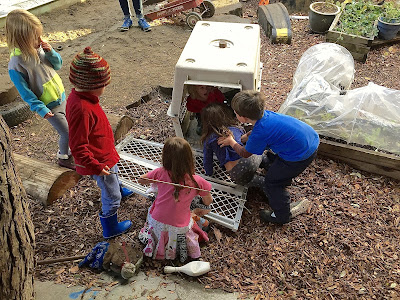They say that the Golden Rule is the only one we need, that every major religion has some version of it embedded in its theology. And it's a good rule, the most familiar iteration being, "Do unto others as you would have them do unto you." But it's not the highest rule. In my book, that honor goes to a rule that the kids agreed to among themselves a few years back: "Don't do anything to anybody unless you ask them first."
The Golden Rule doesn't ask for consent, it just asks each individual to look inward and assume that others feel as we do (empathy), while the kids' rule caused us to turn our attentions outward and to consider that others might feel differently than we do (compassion). We lived with this agreement for the better part of a school year and it was enlightening when considered in view of the recent spat of celebrities and politicians being outed as habitual sexual harassers and worse. These are men, and it's mostly men, who may well have been adhering to the Golden Rule as they saw it, only doing to others what they themselves would want done to them. What's missing from their actions is consent and that's what makes it a crime.
The children's consent rule wasn't easy to enforce. Young children are forever bumping, tickling, hugging, pushing, and otherwise "doing" things to one another just in the natural flow of things. As the adult responsible for helping the children keep their agreements, I didn't feel it was my place to micro-manage these sorts of day-to-day interactions even if they did technically violate the rule of law. To do so would have meant repeatedly interrupting the children's play to remind them of their agreement to the point that there wouldn't have been much time left for the actual playing. Instead, I decided to let the kids self-manage the rule, only getting involved when a child invoked the rule of their own accord.
And they did, "Hey, you didn't ask before you pushed me!"
"You didn't ask if you could touch me!"
"You didn't ask if you could sit beside me!"
"You didn't ask if you could look at me!"
That's right, we did sometimes head down that road. Most of the time the kids invoked their rule appropriately, but we also sometimes took it too far. As the adult, it was easy to know what to do when it came to pushing. I was less confident about the unwanted touching. I had mixed feelings about children using the rule to control where people sat. And dictating where others cast their gaze was a bridge too far.
Needless to say, our consent rule created a gray area, and the only way to deal with it was through talking, sometimes lots of it, sometimes emotional. So that's what we did.

A few school years later, some of the older kids began using the large dog crate on our playground as a kind of prison into which they put one another. They were playing "pets." Those put into the crate were animals that must be confined for their own "safety." The game involved lots of grabbing and wrestling as the pets are usually "reluctant" to be put in their cage. Watching this game as an adult was difficult. Children were "forcing" one another into a small, dark space, then barring the door with an old safety gate, holding it firmly in place while the children inside pretend to object, ultimately escaping before being chased down and returned to their prison. The game evoked so many nasty things for me, especially when it was boys forcing girls. It was a consensual game, yet the core of the game was pretending they
didn't consent. Particularly upsetting for me was that the captor would often say, "I have to put you in your cage to keep you safe," while shoving another child into the hole.
As they played, I stayed nearby, waiting for that moment when I was certain they would go too far, when someone would get frightened, when it would become too real and they wanted to withdraw their consent. We didn't have the consent rule on the books that school year, but we had agreed that if someone says "Stop!" you have to stop, which is a similar thing. A couple times I reminded kids, "Remember, if you don't like what's happening you can say
Stop!" but they just ignored me and continued about their game.
The truth is that none of them asked for my help, either directly or indirectly. They were playing their unsavory-looking game quite happily, managing to keep it going for long stretches, day-after-day, despite its intensity and potential for conflict, injury, and hurt feelings. In part, they were doing it by talking and listening, the pet owners continually informing their pets about what is coming next: "I'm going to grab you and put you back in your cage," "If you get away, I'm going to catch you and bring you back," "I can't let you get out, it's not safe." The pets in this game, as is true in real life, couldn't talk back, so their owners were forever peering into their faces, studying their expressions, looking, I think, for consent. They were forever holding onto their pets, studying their body language, feeling, I think, for consent. At least that's what it looked like they are doing as they played.
I gradually became more comfortable with the kids' game. Even as I continue to be bothered by the optics, I now see that it was, at its core, a game
about consent, about children continually checking in with one another, not with the formality of asking permission, but by "reading" one another, continually, everyone turned outward, following a rule that stands above the golden one.